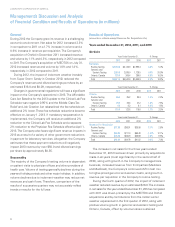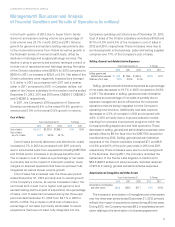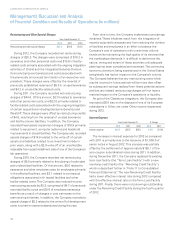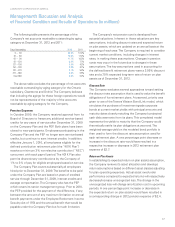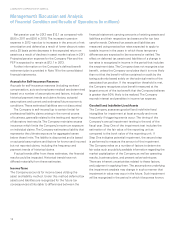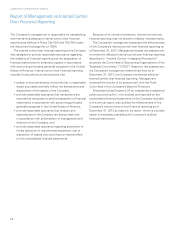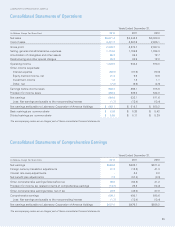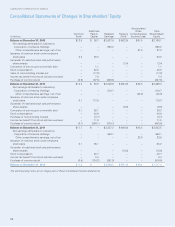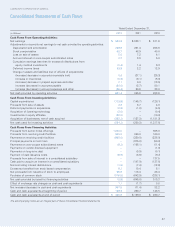LabCorp 2012 Annual Report Download - page 20
Download and view the complete annual report
Please find page 20 of the 2012 LabCorp annual report below. You can navigate through the pages in the report by either clicking on the pages listed below, or by using the keyword search tool below to find specific information within the annual report.18
LABORATORY CORPORATION OF AMERICA
Management’s Discussion and Analysis
of Financial Condition and Results of Operations (in millions)
Net pension cost for 2012 was $12.1 as compared with
$8.6 in 2011 and $9.6 in 2010. The increase in pension
expense in 2012 was due to increases in the amount of net
amortization and deferral as a result of lower discount rates
and a 25 basis points decrease in the expected return on
assets as a result of declines in asset market values in 2011.
Projected pension expense for the Company Plan and the
PEP is expected to remain at $12.1 in 2013.
Further information on the Company’s defined benefit
retirement plan is provided in Note 16 to the consolidated
financial statements.
Accruals for Self-insurance Reserves
Accruals for self-insurance reserves (including workers’
compensation, auto and employee medical) are determined
based on a number of assumptions and factors, including
historical payment trends and claims history, actuarial
assumptions and current and estimated future economic
conditions. These estimated liabilities are not discounted.
The Company is self-insured (up to certain limits) for
professional liability claims arising in the normal course
of business, generally related to the testing and reporting
of laboratory test results. The Company maintains excess
insurance which limits the Company’s maximum exposure
on individual claims. The Company estimates a liability that
represents the ultimate exposure for aggregate losses
below those limits. The liability is discounted and is based
on actuarial assumptions and factors for known and incurred
but not reported claims, including the frequency and
payment trends of historical claims.
If actual trends differ from these estimates, the financial
results could be impacted. Historical trends have not
differed materially from these estimates.
Income Taxes
The Company accounts for income taxes utilizing the
asset and liability method. Under this method deferred tax
assets and liabilities are recognized for the future tax
consequences attributable to differences between the
financial statement carrying amounts of existing assets and
liabilities and their respective tax bases and for tax loss
carryforwards. Deferred tax assets and liabilities are
measured using enacted tax rates expected to apply to
taxable income in the years in which those temporary
differences are expected to be recovered or settled. The
effect on deferred tax assets and liabilities of a change in
tax rates is recognized in income in the period that includes
the enactment date. The Company does not recognize a tax
benefit, unless the Company concludes that it is more likely
than not that the benefit will be sustained on audit by the
taxing authority based solely on the technical merits of the
associated tax position. If the recognition threshold is met,
the Company recognizes a tax benefit measured at the
largest amount of the tax benefit that the Company believes
is greater than 50% likely to be realized. The Company
records interest and penalties in income tax expense.
Goodwill and Indefinite-Lived Assets
The Company assesses goodwill and indefinite-lived
intangibles for impairment at least annually and more
frequently if triggering events occur. The timing of the
Company’s annual impairment testing is the end of the
fiscal year. Step One of the impairment test includes the
estimation of the fair value of the reporting unit as
compared to the book value of the reporting unit. If
Step One indicates potential impairment, the second step
is performed to measure the amount of the impairment.
The Company relies on a number of factors to determine
fair value such as publicly available information regarding the
market capitalization of the Company as well as operating
results, business plans, and present value techniques.
There are inherent uncertainties related to these factors,
and judgment in applying them. The assumptions underlying
the impairment analysis may change in such a manner that
impairment in value may occur in the future. Such impairment
will be recognized in the period in which it becomes known.


